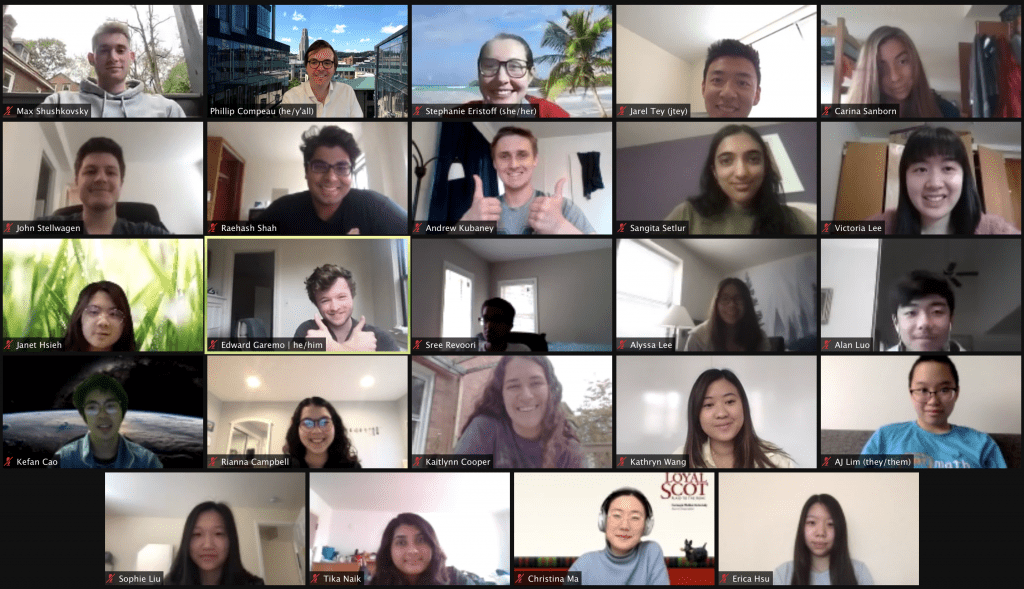Revitalize Online Student Engagement Using a Charity Challenge

Dark Rectangles and the Age of Teaching Loneliness
I pride myself on my attendance policy. University courses can be very poorly attended, but more often than not, my classes have perfect attendance. To show my students that I want them to be there, I reward them with attendance as a percentage of their grade in the course. To make sure they are engaged, I ban phones and laptops from my classroom unless a student needs one to accommodate a disability or we are all working on a coding project together. These policies might seem draconian, but I have found that they don’t just work, but that students appreciate having the structure and focus. The question is how to find comparable ways of increasing online student engagement.
In fall 2020, I did not feel comfortable keeping my attendance policy, since this is such a stressful time for us all, and since many of my students were in time zones that made such a policy impractical. I thought about requiring students who did attend to keep their cameras on, but I also know that there are plenty of reasons why a student might not want to broadcast their working space to their peers.
The end result was that in an effort to be inclusive, I wound up with a teaching experience that was simply no fun. When I am in a classroom, I’m moving around the room, and my wonderful students are constantly asking and answering questions. In fall 2020, I found myself in the same situation as many teachers out there, asking unanswered questions while I stared at a screen full of dark rectangles.
I love looking for ways to be a better teacher, but this crisis of loneliness and a disconnected classroom seemed like a potentially unsolvable problem. Even when I asked students to turn their cameras on if they felt comfortable, it was a matter of minutes before I watched their faces flicker back one by one into the little black rectangles.
How, then, could I get college students to want to attend an online class that is being recorded and that has no attendance policy? And how could I make them want to turn and keep their cameras on when they arrive?
Increasing online student engagement with a deranged idea
In spring 2021, I tried something new in my Great Ideas in Computational Biology class, something that may have been done somewhere before, but that certainly doesn’t seem very mainstream. I incentivized participation in my class with donating my own money to charity.
I’ve tried this sort of thing a bit before in the online space with some minor success, offering a donation for everyone who signed up for the first run of my (free) Programming for Lovers course. But how does it work this semester?
The three dozen students who took my class were required to complete a short preparatory assignment between lectures asking them to describe what they learned in the previous class and ask at least one question about the material. These quizzes were graded on effort and are required only to ensure that students are reviewing their notes and thinking a little bit about what we are doing between classes. I gave $5 to charity every day that everyone in the class completed this assignment.
If all of my students came to class, then I give another $5 to charity that day. Moreover, if everyone who did attend synchronously had their cameras on, then I give another $5. (There are excused reasons for not having cameras on, but I do ask students to let me know if they need to be excused.)
Finally, I rewarded in-class participation by a points system (like a British boarding school, or Hogwarts) in which I gave $1, $2, or $3 each time a student answered a tough question or asked a compelling question.
It was important to me that not only did my students see that I cared enough about their participation to reward it with a donation of my own money, but that the students themselves picked a partner charity that they were interested in. I asked my teaching assistants to get nominations and put together a poll, and my students picked a partner charity called Every1Online.
I am thrilled that my students picked Every1Online for a few reasons. First, it is a project with leadership from within Carnegie Mellon University. Second, it is a great cause, making sure that underrepresented young students in the Pittsburgh area have access to high-speed internet at home. Third, it is a charity with a very clear donation structure, so that students can clearly imagine the impact that their participation is having. If everyone came to a single lecture with their camera on, then that resulted in a month of high speed internet for a family of children who need that connection to succeed.
So … how did it go?
Final amount donated to charity: $442

Every class, we were painfully close to universal completion of the pre-class preparatory assignment, and we reached it once. We had perfect attendance several times, and although most cameras are on most of the time, we struggled with having everyone on board.
However, the points system for in-class participation had a major and impressive impact on increasing online student engagement. Every question I asked would be met with multiple answers, and students saw the benefit in continually asked excellent questions. One of the hidden benefits of teaching synchronously online is that students could constantly ask questions in the chat without interrupting the lecture. A lot of these questions related to understanding and were monitored by students’ peers; if a question is particularly insightful, then I profiled it in class and rewarded points.
I can say, anecdotally, that the experience of teaching was radically better than it was in other COVID semesters. I could see all of my students on one screen! We did yes/no votes in class, and I could see what they think based off of giving me thumbs up or thumbs down.
I even saw a couple of my students raise their hands to ask a question. As in, not click the “raise hand” feature from behind their own dark rectangle. I mean actually, literally, raise their hand while they are sitting at their computer. How wonderful. It gave me hope that we were going to make it through the strange times of pandemic teaching after all.
